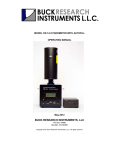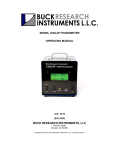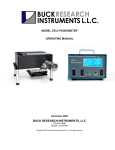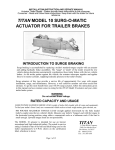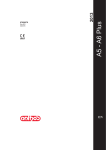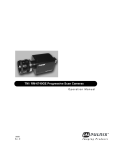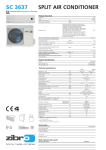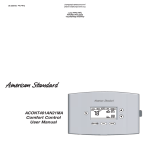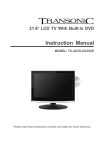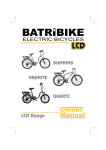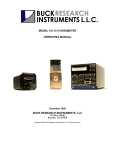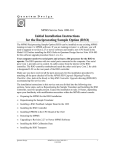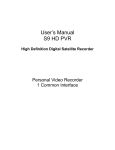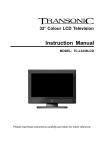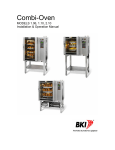Download CR-1A User`s Manual
Transcript
MODEL CR-1A HYGROMETER OPERATING MANUAL May 2008 BUCK RESEARCH INSTRUMENTS, LLC PO Box 19498 Boulder, CO 80308 Copyright 2008. Buck Research Instruments, LLC. All rights reserved. TABLE OF CONTENTS 1. Introduction .................................................................................................................. 4 1.1 General Description ....................................................................................... 4 1.2 Specifications ................................................................................................. 5 2. Location of Principal Components .............................................................................. 6 2.1 Main Unit ....................................................................................................... 6 3. Installation and Operation ........................................................................................... 8 3.1 Installation ..................................................................................................... 8 3.2 Power-up Procedure ...................................................................................... 8 3.3 Operation ........................................................................................................ 9 3.4 Power-down Procedure ................................................................................ 10 4. Signal Processing ....................................................................................................... 11 4.1 Data Signals ................................................................................................. 11 4.2 Data Reduction Equations ............................................................................ 11 5. Principles of Operation .............................................................................................. 5.1 General ......................................................................................................... 5.2 Technical details .......................................................................................... 5.2.1 Sampling System ........................................................................... 5.2.2 Mirror Module ............................................................................... 5.2.3 Optics Module ............................................................................... 5.2.4 Temperature Readout ...................................................................... 12 12 12 12 15 15 15 6. Measurement Limitations .......................................................................................... 16 7. Maintenance and Troubleshooting ............................................................................. 7.1 Sample line Cleaning ................................................................................... 7.2 Mirror Cleaning ............................................................................................ 7.3 Leak Testing ................................................................................................. 7.4 Troubleshooting Guide ................................................................................. Appendix 1: Appendix 2: Appendix 3: Appendix 4: 17 17 17 18 19 Humidity Conversion Equations ................................................................ 20 Connector Pin Assignments ....................................................................... 22 Warranty ..................................................................................................... 23 Mirror cleaning procedure……………………………………….…….......24 2 FIGURES Fig. 1. Main unit............................................................................................................................ 4 Fig. 2. Block diagram, CR-1A chilled mirror hygrometer.......................................................... 13 Fig. 3. Sensor assembly block diagram....................................................................................... 14 3 1. INTRODUCTION The Model CR-1A Cryogenic Hygrometer is a high performance instrument, capable of fast, accurate measurements over an extremely wide humidity range. Because these performance capabilities have not previously been available in a single instrument, the CR-1A represents a significant advance in the state of the art. The CR-1A differs from the original CR-1 primarily by having compact size, light weight, and a linear output signal. There is a battery powered option for portable use for up to 8 hours. There is also an optional version of the CR-1A with an autofill system that allows for continuous operation when connected to a large LN2 dewar and provide continuous use for up to a month at a time. The technology incorporated in the CR1A is protected by domestic and foreign patents. 1.1 General Description The CR-1A is a chilled mirror, condensation type hygrometer. Its high performance is achieved by cryogenically cooling a mirror, using liquid nitrogen or other cryogen, and holding it at the frost point by a heater/control system. Optical detectors sense condensate on mirror, and a thermistor imbedded in the mirror is used to determine mirror temperature--the dew or frost point. Since operation of the CR-1A is based on a fundamental property of water vapor (dew/frost point), it is intrinsically capable of long-term accuracy and stability. The CR-1A features an autobalancing function that automatically adjusts for mirror contamination. To keep a constant layer of dew or frost on the mirror, the reflectivity of the mirror must be measured when the mirror is completely cleared of condensation and when it is completely obscured by condensation. Once this is done, 20% of this span is calculated and set to be the control point. This is achieved by heating the mirror to a high enough temperature to remove condensation, then turning on and off the LED that shines on the mirror. If contamination ever gets to be enough that the control point cannot be achieved, another balance function will be initiated and the control point reset. Once the contamination becomes too great, an LED is illuminated to indicate that the mirror needs to be cleaned. The CR-1A is microcontroller-based. The microcontroller uses flash memory that is fieldprogrammable and updateable. If this is required, please contact Buck Research Instruments, LLC for instructions. The instrument consists of a sensor assembly mounted on a cryogen Dewar, and electronics to provide power, control, displays, and analog output signals, all contained in a single chassis. Great care is taken to ensure maximum reliability and safety of operation, including coolant overpressure protection and dual protection against overheating of the mirror assembly. The components of the CR-1A are: Main assembly, containing dewar, sensor, and electronics Power cable and 24 VDC brick power supply Service kit with spare o-rings and gaskets NISSAN STAINLESS thermos for filling dewar Null modem cable and connector for J2 Operating manual 4 1.2 Specifications, Model CR-1A Cryocooled Hygrometer Measurement range Moisture concentration Dew/Frost point 0.01 to 27,000 ppmv at SP -120 oC to +30 oC Dew/Frost point reading accuracy + 0.15 oC Response time 10-30 sec typical Nominal operating range Ambient Temperature Gas Pressure Flow rate of sample -40 to +40 oC 0 to 150 psia (0-10 bar) .5 - 2 liters/minute Construction 316L stainless steel Dewar capacity Operating time per filling With optional autofill system Loss rate when not in use 0.6 liter 6.0 - 10.0 hours 1 month about 0.6 L/day* Input voltage 100-240 VAC, 50-60 Hz (brick supply) 4500 mAh NiMH battery (optional) Power consumption 25 watts maximum Weight 12.5 lbs (5.7 kg) including batteries Dimensions (chassis) 8" W x 12" D x 11" H (20 x 30 x 27.5 cm) * This is just for reference. DO NOT leave LN2 in the dewar when the CR-1A is off. Note: These are approximate specifications. Exact performance will vary depending on installation and operating environment. 5 2. LOCATION OF PRINCIPAL COMPONENTS 2.1 Main Unit (Figure 1) Front Balance Switch Display Heat/Cool Switch Power Switch Rebalance LED Service Mirror LED Top Black plastic dewar lid with built-in brass pressure relief valve Dewar top with built-in funnel Back RS-232 Connector Dewar Plug Signal Output, J2 Power Connector Sample chamber, pressure connection and outlet Inlet to Sample Chamber Fig. 1. Main unit 6 A. BALANCE SWITCH (momentary). Depress for 5 seconds to initiate a balance cycle. This will heat the mirror up to +30° C to clear off condensation and rebalance the optics circuit. B. HEAT/COOL SWITCH (momentary). Provides additional heat to partially clear the mirror of condensate, or full cooling to allow additional frost to collect on the mirror. Also used to speed initial layer formation. See section 3.2. C. REBALANCE LED. Lights during balance cycle. Also stays lit after balance cycle if there is a small amount of contamination on the mirror. D. DISPLAY. Backlit LCD display that displays H2O concentration, mirror temperature (Mirror T or D/F Point when dew or frost point acquired), pressure (in millibar) and balance (± 200 when dew/frost point acquired). Displays internal main PCB temperature when HEAT/COOL switch depressed. E. POWER SWITCH F. SERVICE MIRROR LED. Flashes when there is too much contamination on mirror. Mirror must be cleaned to restore normal operation of instrument. G. OUTLET AND (Optional) PRESSURE TRANSDUCER. Connect sampling pump or vent here. 1/8” tubing goes to pressure transducer inside instrument. H. OPTICS BLOCK AND CABLE. Contains LED and detector that looks at mirror through lens. Loosen 2 screws inside 2 holes in top of cap to remove optics block to clean mirror. Screws stay captive inside cap. Cable is also captive. I. POWER CONNECTOR. Connect included power supply to this connector. J. RS-232. Connect to data acquisition system or PC running Hyperterminal . K. INLET. Connect tubing to inlet. L. SIGNAL OUTPUT 0-10 V and 4-20 mA outputs for various signals. See section 4. M. DEWAR PLUG. Use dewar plug operator with this plug if the vacuum needs to be recharged. (If the mirror will no longer make -120 ºC the vacuum may need to be recharged.) Please contact Buck Research Instruments, LLC for instructions on how to do this. 7 3. INSTALLATION AND OPERATION 3.1 Installation 1. Inspect the instrument for mechanical or other damage. 2. Connect the inlet and outlet gas flow lines to the sensor assembly. Make sure there is some flexibility in both inlet and outlet lines to avoid stress and possible damage to the CR-4. NOTE: do not over tighten Swagelok-type fittings. Over tightening can destroy their sealing ability. Adjust the flow rate of the gas so that it is less than 2 lpm (4 scf/h). 3. Initially and as often thereafter as necessary, check that all electrical and mechanical connections are secure. It may be advisable to test for leaks using one of the methods in Section 7. This is especially important when operating the instrument in a humidity environment that is very different from that of the sampled air. 3.2 Power-up Procedure 1. Connect the external power supply to the power connector on the back of the instrument. Flip the power switch to the ON position. If unit is supplied with internal batteries, external power supply connection is not required. However, if “LOW BATTERY” Is displayed in place of BALANCE = on the display after the balance cycle in step 2 below completes, reconnect the power supply as the batteries are almost completely discharged and the instrument will soon shut down. 2. After initialization of the electronics, a balance cycle will be initiated. The Rebalance LED will light and the display will show an increasing mirror temperature until +30°C is reached. 3. Fill Dewar with liquid nitrogen. (Please see separate instructions in the appendix if you have the autofill system). First, unscrew the black plastic threaded lid that contains a brass pressure relief valve. This will expose a funnel-shaped lip on the top of the dewar. Use the included NISSAN STAINLESS thermos to fill the dewar. If you put the lip of the thermos to the lip of the dewar lid and tilt slightly, the dewar should fill the fastest possible way. If you tilt too much, there will be splatter of the LN2. You will need to fill the thermos between 2 and 2 1/2times to fill the dewar. When you can see LN2 bubbling at the top of the dewar where the stainless steel bellows is, you are done. Be careful not to overfill. Wait until there is no more boiloff before you screw the lid back on. This should take no more than 5-10 minutes. CAUTION: Use extreme care with liquid nitrogen. Liquid nitrogen has a sea level boiling point of -196 oC, with a large expansion ratio in volume from liquid to gas: approximately 700 to 1. Very brief contact with fluids at cryogenic temperatures can cause injury similar to thermal burns. The eyes are especially vulnerable to this type of exposure. Use a proper transfer container to transfer cryogen to the instrument, and avoid direct contact with 8 any part of body or clothing, wearing safety glasses and clothing as necessary (Caution: fabric gloves can "hold" the liquid nitrogen and must be avoided.) Avoid venting to a confined small space, possibly displacing the air and causing oxygen deprivation. 4. Then, wait for the instrument to stabilize at the operating point. The mirror temperature will decrease until the Balance value gets close to 0. Then the mirror temperature will increase until the Balance voltage stays between ± 200, at which point the display changes from Mirror T to D/F Point and H2O Conc. Will change from XXX.X to a value. 5. The instrument is now ready for use. Connect up the flow of gas. Keep the flow to 2 slpm or less to improve stability and keep the heat load on the mirror to a minimum. The higher the flow rate, the faster the LN2 will boil off. NOTE: It is always advisable to start measuring at relatively high humidity values (above -20oC), to allow easy acquisition of condensation, and then go down in frost point temperature. If it is necessary to begin operating initially at very low frost points, acquisition of frost can be speeded up by use of the HEAT/COOL SWITCH and by spiking the pressure inside the sample chamber. To do this, stop flow through the sample chamber for no more than 1-2 seconds by putting a finger over the outlet of tubing connected to the outlet of the sample chamber, or closing a valve downstream of the outlet of the sample chamber. This will spike the pressure inside the chamber, causing a large amount of moisture to collect on the mirror. Watch the BALANCE value on the display. It will go positive. As soon as the value stops increasing depress the COOL switch and hold it. This will keep the frost layer on the mirror from being burned off and enable readings within 1 or 2 minutes instead of 10 to 20 minutes. 3.3 Operation During operation, no special attention is required except for an occasional check of operating voltages to assure proper function. If possible, keep flow in the range 0.5 - 2 liters/minute (0.25 – 4 scf/h). At very high dew/frost point temperatures, higher flow may be allowed. Keep the sample line inlet protected from contamination. This is best achieved by keeping the sample line closed when not connected to the desired sample gas. WHEN MEASURING WATER CONCENTRATION IN NATURAL GAS, A GLYCOL-ABSORBING FILTER, SUCH AS AN A+ GLYSORB FILTER, MUST BE INSTALLED BEFORE THE INLET TO THE CR-4 OR ERRONEOUS READINGS WILL RESULT. When making a large downward change in humidity, it is better to make several intermediate steps rather than one large step, to avoid losing the condensation layer on the mirror. At low frost point values, always allow time for the moisture levels in the lines and sensing chamber to equilibrate, and for the D/F point temperature to completely stabilize before taking a reading. To avoid internal line condensation and resultant erroneous readings, do not allow the inlet lines to cool below the expected frost point temperature. 9 3.4 Power-down Procedure 1. Watch the display. (For autofill system. See disconnection procedure in appendix.) When the mirror temperature starts to get warmer than the dew point you expect, this indicates that there is no more LN2 in the dewar and you can proceed to step 2. 2. Initiate a balance cycle by depressing the BALANCE switch for 5 seconds. 3. Watch the mirror temperature, if the mirror temperature does not go below 0 C, turn power off. If the mirror temperature goes below 0 C, wait for the mirror temperature to warm up to 0 C before turning off power. 4. Turn off flow of gas to the CR-1A. 5. You can leave the power supply connected to recharge the batteries. HOWEVER, it is not recommended to leave the external power supply connected for long periods of time, as the batteries are continually charged and will start to get hot. We recommend disconnecting the external power supply after 24 hours if the CR-1A is not turned on again and used in that period of time. 10 4. SIGNAL PROCESSING 4.1 Data Signals The following analog signals are available at signal connector J2, and vary over the following ranges: VDF PRES H2O CONC BAL VAMB Mirror temperature (Dew/frost point), 0-10v and 4-20 mA Chamber pressure, 0-10v and 4-20 mA lb/MMscf or ppmv, 0-10v and 4-20 mA (optional) Balance voltage, 0-10v and 4-20 mA Ambient temperature, 0-10v and 4-20 mA (optional) The 4-20 mA outputs sink current. Connect up +24 VDC to the 4-20 mA returns, either using the pins on the connector or from your data acquisition system. The current flowing into the 420 mA returns corresponds with the equations below. 4.2 Data Reduction Equations VDF: Dew/frost point temperature is determined from VDF by: Tdf (°C) = [-150 + 20 x VDF(v)]. Tdf (°C) = [-150 + 8 x IDF(ma)]. (0-10V) (4-20 mA) (1) (2) VAMB: Chamber temperature is determined from VAMB by: Tamb (°C) = [-100 + 20 x VAMB(v)]. Tamb (°C) = [-100 + 8 x IAMB(ma)]. (0-10V) (4-20 mA) (3) (4) PRESSURE: Chamber pressure is calculated from the Vpress signal voltage by: Press = (Vpress – 1.6) * 1.5625 Press = (Ipress – 4) / 1.6 (0 – 10 bar sensor) (/10 for 1 bar sensor) (0 – 10 bar sensor) (/10 for 1 bar sensor) (5) (6) BALANCE: When balanced, BAL = 5V or 12.5 mA. H2O CONC: 2- 4 V = 0-1000 ppbv, 4-6 = 0-1000 ppmv, 6-8 V = 0-1000 PPTV. Conversion to Other Humidity Units To convert dew/frost point readings to other humidity units, refer to Appendix 1. 11 5. PRINCIPLES OF OPERATION 5.1 General The CR-1A is a chilled-mirror, condensation-type hygrometer, consisting of the following principle components: a rhodium plated copper mirror with an attached stem, an associated temperature sensor and heating coil, a liquid nitrogen system for cooling the mirror, an optical system for sensing condensate (mirror reflectance), and control circuitry for controlling mirror temperature via the heating coil. Operation is based on maintaining equilibrium vapor pressure over a water or ice surface on the mirror. Above the equilibrium temperature, mass transport is away from the surface, and below the equilibrium temperature it is onto the surface. When the surface is just at the dew/frost point temperature, the mass of condensate on the surface remains constant. As is the case with conventional cooled dew-point devices, the mirror, optics and electrical circuit make up a thermo-optical servo system which operates to maintain a constant layer of condensate. When condensate is thus equilibrated, mirror temperature is then at the dew/frost point, which is sensed by the imbedded temperature sensor. Since the dew/frost point temperature is a fundamental measure of humidity, the CR-1A is intrinsically capable of long term accuracy and stability. The development of this hygrometer follows the original work of H.J. Mastenbrook at NRL. His work was adapted by the NOAA Geophysical Monitoring for Climatic Change (GMCC) program for balloon-borne stratospheric water vapor measurements. Buck Research has extensively redesigned and reconfigured the instrument for a broader range of measurements and applications, incorporating proprietary new technical innovations in the process. 5.2 Technical details A block diagram of the cryocooled hygrometer is given in Figure 2 and the sensor assembly is diagrammed in Figure 3. 5.2.1 Sampling system The gas to be measured (sample gas) is brought to the sensing chamber through an inlet system and allowed to flow across the mirror surface in the sensor chamber. At the exit of the sensor chamber, the sample gas flows by a pressure gauge and is then returned to the original gas stream or exhausted as desired. 12 Fig. 2. Block diagram, CR-1A chilled mirror hygrometer 13 Fig. 3. Sensor assembly block diagram 14 The sampling system must be carefully sealed to prevent room or cabin air from contaminating the measurements. Stainless steel materials must be used throughout the inlet portion to minimize outgassing during low humidity sampling. 5.2.2 Mirror Module The mirror assembly consists of a mirror, a mirror support, and the RTD, heater, and sensor that are attached to the mirror. A small ultra-stable RTD is installed beneath the mirror face to measure the dew/frost point temperature. Heating is provided by a resistive heater coil wound around the mirror stem. 5.2.3 Optics Module The mirror surface is maintained continuously and automatically at the frost-point temperature by an electro-optical control system. This system measures the quantity of light specularly reflected from the mirror condensate and maintains a constant reflectance at the mirror surface, thus providing the condensate equilibrium for the frost-point temperature. The optics module consists of a photodiode pair and a light emitting diode (LED). One photodiode maintains constant LED intensity; the other photodiode provides a current output that is proportional to the light reflected from the mirror. The bias circuit is set so that when the proper condensation layer is on the mirror, about 80% of the light emitted by the LED is received at the detector. . 5.2.4 RTD Readout For obtaining the dew or frost point temperature from the temperature senor, three readouts are provided: VDF signal voltage, RS-232 output and a direct temperature indication on the display. All are accurate within ±0.15oC throughout the measurement range. 15 6. MEASUREMENT LIMITATIONS Under field operations, measurement errors can arise from a number of causes. Any deviation of the mirror temperature from the frost-point temperature will of course cause error. Perhaps the most common error source is from outside air leaking into the hygrometer sampling system. Therefore, it is important that the instrument be leak tested periodically, and with each relocation of the instrument, especially if components of the instrument have been exchanged or serviced. Long exposure of the sampling system to high humidities, or condensation of water (which occurs if cold surfaces are exposed to ambient air which has a higher dew point than the temperature of the surfaces) causes temporarily high readings until the walls have completely outgassed. The lines may take a very long time to dry enough to allow accurate readings when measuring frost points below -50oC. Any hygroscopic material in the lines or chamber, such as dust, further lengthens this time. It is therefore advised to keep the lines clean and dry. Calibration of the mirror temperature sensor and associated electronics is required to accurately determine dew/frost point temperature. Buck Research Instruments has done this. Once calibrated, the temperature sensor has been found to exhibit no measurable drift, even after years of use. Low drift components are used throughout the temperature sensing circuit to ensure long-term accuracy. However, recertification and recalibration is recommended yearly to ensure proper operation. Errors can arise from failure to correct for differences between chamber pressure and ambient values. This is only important if you are measuring ambient dew/frost point and not H2O concentration. The system must be allowed to fully equilibrate before accurate readings can be obtained. When measuring very low frost points, equilibration can take much longer. Within twenty degrees below freezing, the existence of supercooled water on the mirror can cause the temperature to read low, as the instrument is measuring dew point. Eventually the dew will turn to frost. To speed this up, press the COOL switch and allow the mirror to cool 510 degrees below the dew point reading, then release COOL switch. This will convert the dew to frost, as long as the mirror temperature does not go above 0° C after COOL switch is released Contamination of the mirror by salt or other electrolytes can vary the relationship between vapor pressure and dew/frost point (Raoult error). Other chemical contamination may cause similar error. This is particularly relevant when measuring in natural gas, as glycols contained within it can condense out on the mirror. This is why a glycol-absorbing filter must be used when measuring natural gas. 16 7. MAINTENANCE AND TROUBLESHOOTING The following maintenance items should receive attention as required: 1. Cleaning of sample lines, depending on use (Sect. 7.1). 1. Mirror check and cleaning (Sect. 7.2). 2. Leak checking (Sect. 7.3) 7.1 Sample line Cleaning To keep sample lines clean, thus improving response at very low humidities, wash with water or acetone and blow dry with a mild pressure from a dry air or nitrogen source. It may be desirable to heat the lines for a few moments to drive off residual water. 7.2 Mirror cleaning The mirror should be cleaned when the Check Mirror LED is flashing. 1. Make certain mirror is at or near the room temperature and power has been shut off. There are 2 holes in the flat part of the optics block. Insert hex ball driver into holes and loosen each screw. The screws will remain captive inside. Once screws are loose, remove optics block. It will be held by the cable coming out of it, which is not removable. The mirror is now exposed and can be cleaned. 2. See Appendix 4 for detailed procedure. 3. If necessary, repeat process. If contamination persists, clean again with acetone, followed by water, using a small amount. Never use alcohol in the sensing chamber, as this affects the hygroscopic properties of the mirror surface for some period of time. (In the absence of acetone, distilled water alone or used after acetone or MEK can be effective.) CAUTION: The mirror surface has a coating that scratches easily. However, moderate scratching does not prevent normal operation. Use only soft flexible cotton swabs to clean the mirror. Apply minimal pressure 4. Turn instrument power on and wait and see if Service Mirror LED and Rebalance LEDs turn off. If either or both LEDs stay lit, try cleaning the mirror again. Make sure the mirror is completely dry before turning power on. 5. If the Service Mirror LED cannot be turned off by cleaning the mirror, remove the optics block and clean the lens and entire sample chamber. 17 7.3 Leak Testing The introduction of even small amounts of room air into the sampling system will cause errors in low frost point readings. Therefore, it is desirable that leak testing be performed on the instrument package and sampling system after initial assembly, and after any maintenance activity that involves disassembly of the instrument or interconnecting tubing. Method 1. Connect a vacuum pump and vacuum gauge to the sampling system inlet port, and close or cap the outlet port (or vice versa). Evacuate down to the minimum attainable pressure. A reading of 100 microns Hg or less indicates the system is adequately sealed. To locate a leak, place a few drops of alcohol on each tubing connection and watch the vacuum gauge pressure reading. If the reading abruptly increases, there is a leak. Allow some time for the vacuum readings to recover after each upscale deflection before proceeding to the next connection. Method 2. If the vacuum pumping system is unable to evacuate the inlet plumbing to a level that will produce an on-scale reading on the vacuum gauge, disconnect the vacuum pump from the gas inlet port and replace it with a low-pressure air supply with a needle valve for regulation. Slowly pressurize the gas inlet tubing, being careful to limit the pressure applied to no more than two atmospheres. Dampen the inlet tubing connections with soap solution or other leak detection solution, and watch for air bubbles forming at each connection. The presence of any air bubbles indicates a leak at the connection. Repair any connections found leaking and recheck for leaks. When no more bubbles can be found, disconnect the lowpressure air supply and reconnect the vacuum pumping system. Repeat the preceding vacuum leak testing procedure. CAUTION: Overpressure within the above limits will not damage the pressure sensor. However, slight calibration adjustments may be necessary after any overpressure. Overpressure limit: 100% of span. Method 3. Plug one end of the sensing chamber. Attach an ordinary pump with a shutoff valve to the other end. Lower the pressure as much as possible. Close the shutoff valve and monitor pressure inside the sensing chamber to determine leak rate. With proper sealing, the pressure change rate should be less than 0.2 % of pressure differential per minute. Leaks can then be located by overpressuring the instrument as in Method 2. 7.4 Troubleshooting Guide 18 Display shows Mirror needs cleaning. Service Mirror LED blinking: 1. Mirror needs cleaning. Clean mirror 2. Optics cable is disconnected. Reconnect optics cable. Rebalance LED stays lit after balance cycle finishes: 1. Mirror starting to get contaminated. CR-1A will continue to function normally, but be prepared to clean mirror soon. Oscillation of output : 1. Reduce sample flow until oscillation stops, then gradually increase flow again. 2. Turn instrument off, allow to warm up, and clean mirror. 3. If oscillation is slow (10-20 sec period) and most pronounced in the region -30 to 50oC, cavity resonance (interaction with contaminants in the chamber) may be occurring. Clean sensing chamber with the CR-1A cleaning fluid supplied. 19 APPENDIX 1: HUMIDITY CONVERSION EQUATIONS (Revised 7/96) Computer-efficient algorithms for converting among several humidity units, as used in HCON, are given here. They utilize vapor pressure formulations developed by A. Buck (1981). DP e es P r RH rho rhos T Tk = dew or frost point in deg C = vapor pressure in millibars = saturation vapor pressure in millibars = pressure in millibars = mixing ratio by weight in ppm = relative humidity in percent = absolute humidity in g/m3 = absolute humidity at saturation = temperature in deg C = absolute temperature in K Saturation vapor pressure (es) = f1(T) = e/RH Dew/frost point (DP) = f2(e) = f2[r x P/(622 x 103 + r] = f2(RH x f1(T)/100) = f2(rho x Tk/216.7) (e) (r) (RH) (rho) Vapor pressure (e) = f1(DP) = r x P/(622 x 103 + r) = RH x f1(T)/100 = rho x Tk/216.7 (DP) (r) (RH) (rho) Mixing ratio (r), ppmw = 622x103 x e/(P-e) = 622x103 x f1(DP)/[P - f1(DP)] = 622x103 x RH x es/(100 x P - RH x es) = 622x103 x rho x Tk/(216.7 x P - rho x Tk) (e) (DP) (RH) (rho) Relative humidity (RH) = 100 x f1(DP)/f1(T) = 100 x e/es = 100 x r x P/[(622x103 + r) x es] = 100 x rho x Tk/(216.7 x es) (DP) (e) (r) (rho) Absolute humidity (rho)= 216.7 x f1(DP)/Tk = 216.7 x e/Tk = 0.2167 x r x P/[(622 + .001 x r) x Tk] = 216.7 x RH x es/(100 x Tk) (DP) (e) (r) (RH) mixing ratio by volume (ppmv) = mixing ratio by weight (ppmw) x 1.6077 grains/lb = r x 0.007 Precipitable cm per km = rho/10 20 - 21 - NOTE 1: f1(DP) and f2(e) are variations on vapor pressure formulations found in Buck, A: J Appl Met 20, pp 1527-1532 (1981). They are given by: e vs. DP or es vs. T: f1(DP) = EF x aw x exp [(bw - DP/dw) x DP/(DP + cw)] (over water) = EF x ai x exp [(bi - DP/di) x DP/(DP + ci)] (over ice) DP vs. e or T vs. es: f2(e) = dw/2 x [bw - s - ((bw - s)2 - 4 cw x s/dw)1/2] = di/2 x [bi - s - ((bi - s)2 - 4 ci x s/di)1/2] (over water) (over ice) where: aw = 6.1121 bw = 18.678 cw = 257.14 dw = 234.5 ai = 6.1115 bi = 23.036 ci = 279.82 di = 333.7 s = ln (e/EF) - ln (aw or ai) 2 EFw = 1 + 10-4 [7.2 + P (0.0320 + 5.9 x 10-6 T )], 2 EFi = 1 + 10-4 [2.2 + P (0.0383 + 6.4 x 10-6 T )], where P is in kPa and T is in oC. NOTE 2: RH is defined here using es with respect to ice below freezing. However, RH is also frequently defined using es with respect to water, even below freezing. NOTE 3: These conversions are intended for use with moist air rather than pure water vapor. They therefore include EF, the enhancement factor, which corrects for the slight departure of the behavior of water in air from that of a pure gas. NOTE 4: The definitions f1 and f2 for ice agree with an extrapolation of NBS values down to -120 deg C, within 0.5%. 21 APPENDIX 2: CONNECTOR PIN ASSIGNMENTS J2 16-pin Signal connector Pin 1 2 3 4 5 6 7 8 9 10 11 12 13 14 15 16 Balance (0-10 V) Balance Return Balance (4-20 mA) (DC Power) Balance (4-20 mA) Return (for self-powered loops) Pressure (0-10 V) Pressure Return Pressure (4-20 mA) Pressure (4-20 mA) Return VDF (0-10 V) VDF Return VDF (4-20 mA) VDF (4-20 mA) Return Dew Point (0-5 V) Dew Point Return Dew Point (4-20 mA) Dew Point (4-20 mA) Return J4 RS-232 connector 9600 Baud, 8-N-1. Flow control set to NONE. Use null modem cable with Female/Female ends.(Included) APPENDIX 3:WARRANTY Manufacturer warrants that the items delivered shall be free from defects (latent and patent) in material and workmanship for a period of one year after acceptance of the specific goods by Buyer. The Buyer’s sole and exclusive remedy under this warranty shall be limited to repair or replacement. Defective goods must be returned to the Manufacturer promptly after the discovery of any defect within the above referenced one-year period. Transportation expenses to return unit to Manufacturer shall be borne by the Buyer. Return shipping to Buyer shall be borne by Manufacturer for valid warranty claims. This warranty shall become inapplicable in instances where the items have been misused or otherwise subjected to negligence by the Buyer NOTWITHSTANDING ANY OTHER PROVISION OF THIS CONTRACT, NO OTHER WARRANTIES WHETHER STATUTORY OR ARISING BY OPERATION OF LAW, EXPRESSED OR IMPLIED, INCLUDING BUT NOT LIMITED TO THOSE OF MERCHANTABILITY OR FITNESS FOR PARTICULAR PURPOSE, SHALL APPLY TO THE GOODS OR SERVICES PROVIDED HEREUNDER, OTHER THAN THE REPAIR AND REPLACEMENT WARRANTY ABOVE . SELLER SHALL IN NO EVENT BE LIABLE TO BUYER OR ANY THIRD PARTY FOR ANY DAMAGE, INJURY OR LOSS, INCLUDING LOSS OF USE OR ANY DIRECT OR INDIRECT INCEDENTAL OR CONSEQUENTIAL DAMAGES OF ANY KIND. 23 Appendix 4. CR-1A Mirror Cleaning Procedure Removal Insert 5/64” ball driver through the 2 top holes of the optics cap to find the #2-56 socket head screws inside. Loosen those screws to remove the optics block. Using the 9/64” ball driver, completely remove all 6 #8-32 socket head screws from the lens holder. Be careful when removing the last screw as there is a nickel gasket (or rubber oring) in between the lens holder and the top of the sample chamber. Also, the lens sticks out of the lens holder, so do not place the lens holder lens-side down. Always have the lens facing you when setting the lens holder down. You should be able to reuse the gasket about 10 times, and if you are lucky and do not touch it, the gasket will stay in place. Cleaning the Mirror Once you have access to the mirror, dip a cotton tipped applicator in acetone and clean the mirror gently. Use each applicator only once. After the mirror has been cleaned with acetone, wipe the mirror with a dry applicator. Then dip another applicator in water and wipe the mirror off again. Finally, wipe the mirror off with a dry applicator to complete the cleaning process. Replacement Now, put the lens holder back on the sample chamber.Use the index marks to get the correct alignment. Start middle 2 screws that are 180 degrees apart. Leave a ¼” gap for the gasket if the gasket has separated from the sample chamber. Next, insert the bottom 2 socket head screws to prevent the gasket from falling through. Drop the gasket into the ¼” gap making sure that it is in the correct position before tightening the screws any further. If the gasket is sitting too low a small metal strip or a metal ruler can be used to lift the gasket ( or optional viton o-ring) back into place. Tighten the captive screws first, using the 9/64” ball driver. Alternate back and forth between both screws. Tighten the other 4 socket head screws making sure that there is no gap between the sample chamber and the lens holder. Do not use excessive force when tightening the screws. Do a leak check now. If there is a leak, alternate tightening the 6 screws by tightening the screw 180 degrees from the one just tightened, then move to the next screw and do the same thing. (If you number the screws 1-6 where 1 is on the top, go 1-4-2-5-3-6.) You may need to use a right-angle 9/64” hex key to get more torque if the ball driver will not tighten the screws any more. Lastly, put the optics block and cap back on using the 5/64’ ball driver. Insert the ball driver into the 2 holes on top of the optics cap to find the socket head screws in the optics block. Make sure that there is no gap between the optics block and the lens holder. 24 Addendum: Key stroke input to RS-232 c C p P d D i I decrease the contrast of the LCD display by 2% increase the contrast of the LCD display by 2% decrease the proportional gain coefficient by 2/3rds increase the proportional gain coefficient by 50% decrease the derivative gain coefficient by 2/3rds increase the derivative gain coefficient by 50% decrease the integrator time constant coefficient by 2/3rds increase the integrator time constant coefficient by 50% Each repeated key press is progressive. For example, 5 C presses will increase the contrast by 10%. 5 p presses will decrease the gain by about 87% R B resets all coefficients and contrast to original values initiates a balance routine 25

























